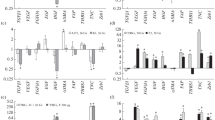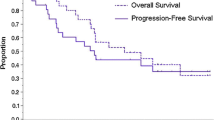Summary
We have shown in earlier studies that repeated weekly exposures of a human astrocytoma clone (AST 3–4) to MeCCNU (10 μg/ml for 1 h per week) produced a linear decrease in survival over the first 3 weekly treatments. But, after that time these cells became progressively more resistant to the 10 μg/ml concentration of the agent. In the studies reported here we show that these previously treated cells were also less responsive to other doses ranging from 1 to 30 μg MeCCNU/ml. This change in sensitivity to MeCCNU was accompanied by collateral changes in response to other agents: resistance to BCNU and Galactitol, increased sensitivity to Adriamycin, and no change to ionizing radiation. These experiments suggest that once repeated treatments with a single agent cause a tumor cell population to become more resistant, sensitivity to other agents may also change unpredictably.
Similar content being viewed by others
Abbreviations
- DAG:
-
Galactitol
- Adria:
-
Adriamycin
- PCNU:
-
1-(2-Chloroethyl)-3-(2,6 dioxo-3-piperidyl-1-nitrosourea)
- MeCCNU:
-
1-(2-chloroethyl)-3-(4-methylcyclohexyl)-1-nitrosourea
- BCNU:
-
1,3-bis(2-chloroethyl)-1-nitrosourea
- FMF:
-
Flow microfluorometry
References
Barranco SC, Townsend Jr CM, Koester SK, Ho BY, Reumont KJ: Treatment-induced changes in sensitivity in a multiclonal human tumor mixture model in vitro. Cancer Res 48:2749–2755, 1988
Barlogie B, Göhde W, Johnston DA, Smallwood L, Schumann J, Drewinko B, Freireich EJ: Determination of ploidy and proliferative characteristics of human solid tumors by pulse cytophotometry. Cancer Res 38:3333–3339, 1978
Rubin NH, Casartelli C, Macik BG, Boerwinkle WR, Barranco SC: In Vitro cellular characteristics and survival responses of human astrocytoma clones to chloroethyl-nitrosoureas and diahydrogalactitol. Invest New Drugs 1:129–137, 1983
Barranco SC, Townsend Jr CM: Loss in cell killing effectiveness of anticancer drugs in human gastric cancer clones due to recovery from potentially lethal damage in vitro. Cancer Res 46:623–628, 1986.
Schabel Jr FM, Trader MW, Laster Jr WR, Wheller GP, Witt MH: Patterns of resistance and therapeutic synergism among alkylating agents. Antibiot Chemother 23:200–215, 1978.
Teicher BA, Cucchi CA, Lee JB, Flatow JL, Rosowsky A, Frei E III: Alkylating agents: in vitro studies of cross-resistance patterns in human cell lines. Cancer Res 46: 4379–4383, 1986
Griswold Jr DP, Trader MW, Frei E III, Peters WP, Wolpert MK, Laster Jr WR: Response of drug-sensitive and -resistant L1210 leukemias to high-dose chemotherapy. Cancer Res 47:2323–2327, 1987
Miller BE, Miller FG, Heppner GH: Interactions between tumor subpopulations affecting their sensitivity to the antineoplastic agents cyclophosphamide and methotrexate. Cancer Res 41:4378–4381, 1981
Woodruff MF, Ansell JD, Forbes GM, Gordon JC, Burton DI, Micklem HS: Clonal interactions in tumors. Nature 229–5886, 822–824, 1982
Brouwer M, de Ley L, Feltkamp CA, Elema J, Jongsma AP: Serum-dependent “cannibalism” and autodestruction in cultures of human small cell carcinoma of the lung. Cancer Res 44:2947–2951, 1984
Greenberg G, Burnstock G: A novel cell-to-cell interaction between mast cells and other cell types. Exp Cell Res 147:1–13, 1983
Zipori D, Friedman A, Tamir M, Silverberg D, Malik Z: Cultured mouse marrow and monocytes. J Cellular Phys 118:143–152, 1984
Benke R, Werling HO, Paweletz N: Studies on confrontation of different tumor cells with human diploid fibroblasts. Anticancer Res 4:241–246, 1984
Heppner GH, Miller B, Copper DN, Miller FR: Growth interactions between mammary tumor cells. In: McGrath CM, Brennan MJ, Rich MA (eds.) Cell biology of breast cancer. 1980, pp 161–172
Kartner N, Riordan JR, Ling V: Cell surface p-glycoprotein associated with multidrug resistance in mammalian cell lines. Science, 221:1285–1288, 1983
Tofilon PJ, Buckley N, Deen DF: Effect of cell-cell interactions on drug sensitivity and growth of drug-sensitive and- resistance tumor cells in spheroids. Science 226:862–864, 1984
Author information
Authors and Affiliations
Additional information
Dedicated to the memory of Benjamin Drewinko, Physician, Scientist and friend.
Rights and permissions
About this article
Cite this article
Barranco, S.C., Townsend, C.M., Jenkins, V.K. et al. Changes in drug sensitivity of a human astrocytoma clone previously treated with 1-(2-chloroethyl)-3-(4-methylcyclohexyl)-1-nitrosourea in vitro . Invest New Drugs 6, 293–298 (1988). https://doi.org/10.1007/BF00173647
Issue Date:
DOI: https://doi.org/10.1007/BF00173647




